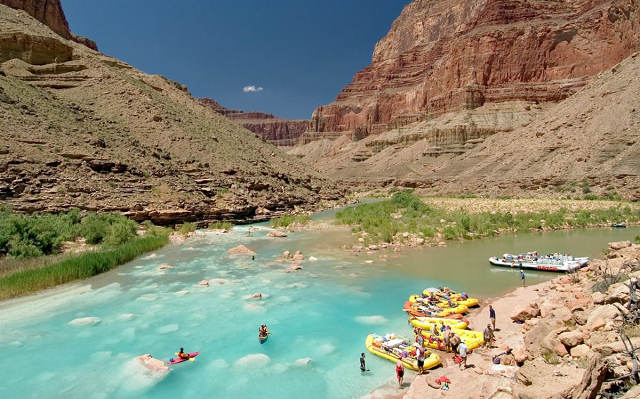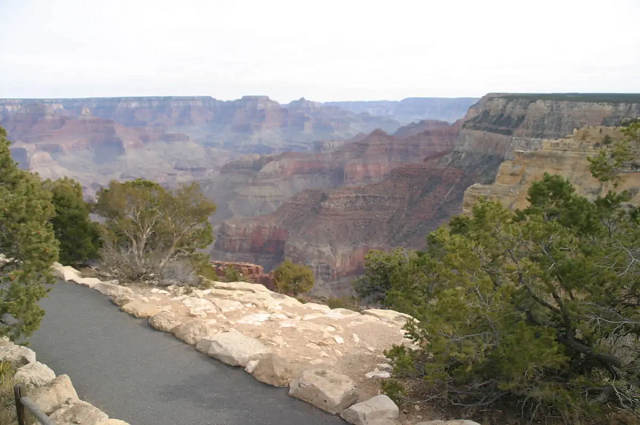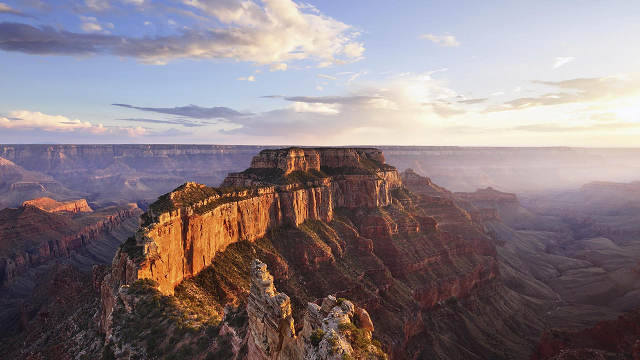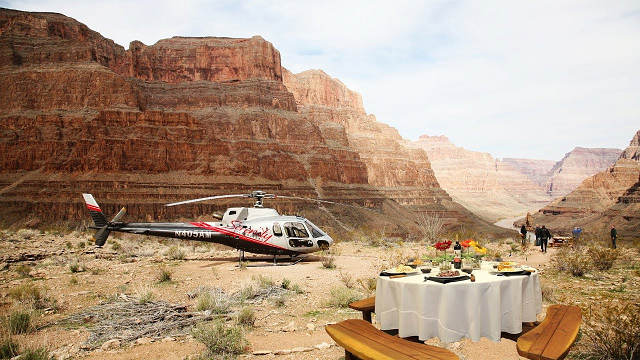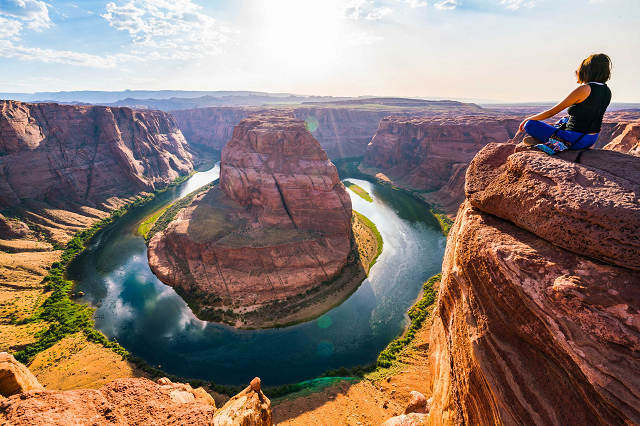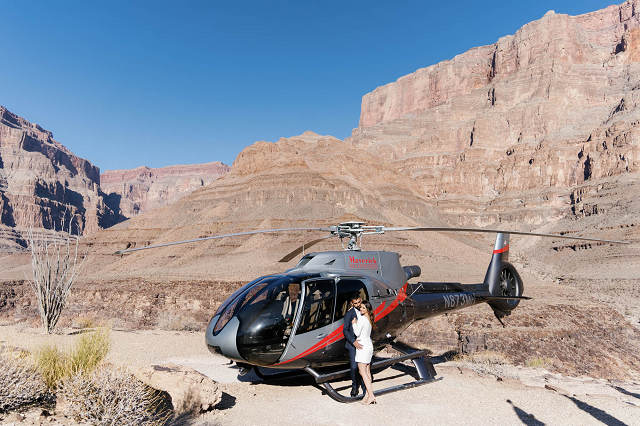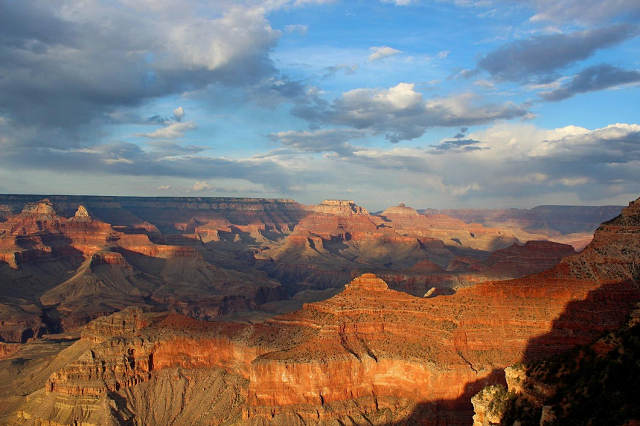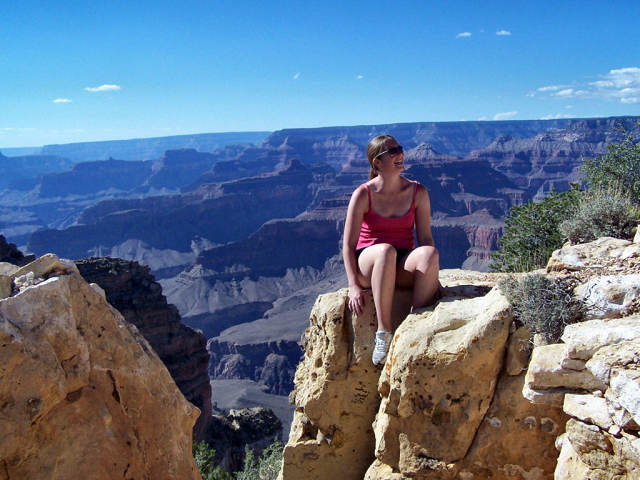Grand Canyon Tour Packages From Las Vegas Welcome to the breathtaking world of the Grand Canyon, a natural wonder that
;leaves visitors in awe of its sheer beauty and grandeur. Carved over millions of years by the mighty Colorado River, the Grand Canyon stands as a testament to the marvels of geological processes. With its mesmerizing vistas, towering cliffs, and vibrant colors, it is no wonder that the Grand Canyon attracts millions of visitors from around the globe each year.
Why Las Vegas is the Perfect Gateway to the Grand Canyon
Nestled amidst the glitz and glamour of the Las Vegas Strip, Las Vegas serves as the ideal gateway to embark on an unforgettable journey to the Grand Canyon. Not only does Las Vegas offer a myriad of entertainment options, world-class dining, and luxurious accommodations, but it also provides convenient access to the various sections of the Grand Canyon, making it a popular starting point for many adventurers.
Overview of Grand Canyon Tour Packages
Whether you are a thrill-seeker, nature lover, or photography enthusiast, there’s a perfect Grand Canyon tour package waiting for you. From exhilarating helicopter tours that soar over the majestic canyon to leisurely bus tours that allow you to savor every moment, and from adventurous hiking tours that take you deep into the heart of the canyon to serene rafting tours along the Colorado River – the options are as diverse as the canyon itself. Join us as we delve into the wonders that await you on your Grand Canyon adventure.
Getting Ready for the Adventure
Before you embark on your thrilling Grand Canyon adventure, it’s essential to prepare yourself for an unforgettable experience. From packing the right essentials to choosing the perfect tour package, proper preparation ensures you make the most of your time at this natural wonder.
A. Packing Essentials for the Grand Canyon Tour
-
Clothing and Footwear:
- Comfortable and sturdy hiking boots or closed-toe shoes
- Moisture-wicking socks to keep your feet dry during hikes
- Lightweight, breathable clothing suitable for the season
- Layering options to adjust to changing temperatures
-
Sunscreen and Hydration:
- High SPF sunscreen to protect your skin from the intense desert sun
- Wide-brimmed hat or cap for additional sun protection
- Refillable water bottles to stay hydrated throughout the day
-
Camera and Binoculars:
- High-quality camera to capture the awe-inspiring scenery
- Binoculars for a closer look at the distant canyon features and wildlife
B. Choosing the Right Tour Package
-
Helicopter Tours:
- Overview: Experience the Grand Canyon from an exhilarating aerial perspective. Helicopter tours offer breathtaking views of the canyon’s vastness, winding Colorado River, and iconic rock formations.
- Highlights: Soar over the Grand Canyon Skywalk, Hoover Dam, and other points of interest for a truly unique experience.
- Ideal for: Those seeking a thrilling and time-efficient adventure with limited physical exertion.
-
Bus Tours:
- Overview: Sit back, relax, and enjoy the journey as comfortable buses take you to key lookout points and attractions. Bus tours often provide informative narration from knowledgeable guides.
- Highlights: Explore the South Rim, North Rim, and other scenic spots, and capture picture-perfect moments along the way.
- Ideal for: Travelers looking for a comprehensive Grand Canyon experience with minimal physical activity.
-
Hiking Tours:
- Overview: Immerse yourself in the canyon’s beauty with guided hiking tours. Traverse scenic trails and witness the breathtaking landscape up close.
- Highlights: Descend into the canyon, explore hidden gems, and learn about the geology and flora from expert guides.
- Ideal for: Adventurous souls who enjoy physical activity and want an in-depth exploration of the Grand Canyon.
-
Rafting Tours:
- Overview: Embark on a thrilling rafting expedition along the Colorado River, through the heart of the canyon.
- Highlights: Experience the canyon from a unique vantage point, tackle thrilling rapids, and camp under the stars.
- Ideal for: Adventure enthusiasts seeking a water-based escapade in one of the world’s most iconic settings.
Selecting the right tour package that aligns with your preferences and interests will set the tone for an incredible journey through the majestic Grand Canyon. Whether you opt for the excitement of a helicopter tour or the immersive experience of a hiking adventure, your Grand Canyon expedition promises to be an unforgettable escapade into the heart of nature’s masterpiece.
The Best Time to Visit the Grand Canyon
The Grand Canyon is a year-round destination, each season offering its unique charm and experiences. To make the most of your visit, it’s essential to understand the different seasons and their impact on the canyon’s landscape and weather.
A. Exploring Different Seasons
-
Spring:
- Timeframe: March to May
- Highlights: Spring brings mild temperatures, blooming wildflowers, and lush greenery. It is an excellent time for hiking and outdoor activities. Be prepared for occasional rain showers.
-
Summer:
- Timeframe: June to August
- Highlights: Summer offers hot and sunny days, making it ideal for helicopter tours and water-based activities. The North Rim is fully accessible during this season. Prepare for crowds and make reservations in advance.
-
Fall:
- Timeframe: September to November
- Highlights: Fall showcases vibrant foliage as the leaves change color, creating a breathtaking sight. The weather is generally pleasant, making it perfect for hiking and camping. Be aware of potential early snow at the North Rim.
-
Winter:
- Timeframe: December to February
- Highlights: Winter brings cooler temperatures and occasional snow, transforming the canyon into a winter wonderland. The South Rim remains open year-round, offering unique photography opportunities and a quieter atmosphere.
B. Special Events and Festivals at the Grand Canyon
-
Star Parties:
- Timeframe: Various dates throughout the year
- Highlights: Attend night-sky programs and stargazing events organized by the National Park Service. Experience the wonder of the canyon under a canopy of stars.
-
Native American Cultural Celebrations:
- Timeframe: Seasonal events and ceremonies
-
Highlights: Participate in cultural events that showcase the rich traditions and heritage of Native American tribes. Learn about their connection to the Grand Canyon and its significance.
-
Ranger-Led Programs:
- Timeframe: Offered throughout the year
- Highlights: Join ranger-led walks, talks, and demonstrations that provide valuable insights into the canyon’s geology, history, and wildlife.
No matter the season, the Grand Canyon offers something truly extraordinary. Each time of year presents an opportunity to witness the canyon’s ever-changing beauty and engage in activities that suit your preferences. Whether you prefer the vibrant colors of fall, the tranquility of winter, the blossoming of spring, or the adventures of summer, the Grand Canyon awaits you with its timeless allure. Plan your visit wisely, and you’ll be rewarded with a memorable experience in this natural wonder that will stay with you for a lifetime.
Awe-Inspiring Views and Points of Interest
The Grand Canyon is a visual masterpiece, offering a plethora of awe-inspiring views and points of interest that will leave you breathless. From majestic overlooks to iconic landmarks, each location offers a unique perspective of the canyon’s grandeur.
A. Grand Canyon Skywalk
The Grand Canyon Skywalk is a renowned glass bridge that extends over the edge of the West Rim, providing an exhilarating vantage point. Walk on the transparent floor for a thrilling experience, feeling as if you are suspended above the 4,000-foot drop to the canyon floor. The Skywalk offers unparalleled views of the Colorado River and the magnificent canyon walls.
B. South Rim Lookout Points
- Mather Point:
- One of the most popular and easily accessible lookout points.
- Offers panoramic views of the canyon’s vastness and the Colorado River winding through the landscape.
- Hopi Point:
- Famous for its unparalleled sunset vistas.
- The perfect spot to capture stunning photographs as the colors of the canyon transform with the setting sun.
- Yavapai Point and Geology Museum:
- Educational exhibits at the Geology Museum provide insights into the canyon’s geologic history.
- Yavapai Point offers breathtaking views of the Bright Angel Trail and the Phantom Ranch below.
C. North Rim Lookout Points
- Point Imperial:
- The highest point on the North Rim, offering sweeping views of the eastern Grand Canyon and the Painted Desert.
- A less crowded alternative to some of the South Rim viewpoints.
- Cape Royal:
- Provides incredible panoramas of the Colorado River’s winding path through the canyon.
- A must-visit during sunrise and sunset for magical colors across the sky.
D. Bright Angel Trail
Embark on a hike along the iconic Bright Angel Trail, which offers a chance to venture into the heart of the canyon. The trail descends from the South Rim, and while the full hike to the Colorado River is challenging and requires careful planning, shorter sections still offer breathtaking views and rewarding experiences.
E. Havasu Falls
Located within the Havasupai Indian Reservation, Havasu Falls is a stunning oasis of turquoise waters and cascading waterfalls amid the red rock canyon walls. Accessible by a challenging hike, the reward is a magical and surreal landscape that seems like it’s straight out of a dream.
F. Desert View Watchtower
Designed by Mary Colter, the Desert View Watchtower is both an architectural marvel and a fantastic viewpoint. Climb to the top for panoramic views of the Colorado River and the eastern canyon.
G. Horseshoe Bend
Though not part of the Grand Canyon National Park, nearby Horseshoe Bend is a must-visit. This horseshoe-shaped meander of the Colorado River offers a jaw-dropping sight from the overlook, showcasing the river’s power as it winds through the red sandstone.
Exploring these awe-inspiring viewpoints and landmarks will undoubtedly be the highlight of your Grand Canyon adventure. Be sure to bring your camera and take your time soaking in the breathtaking scenery that nature has crafted over millions of years.
Wildlife and Flora at the Grand Canyon
The Grand Canyon is not only a geological wonder but also a thriving ecosystem that supports a diverse array of wildlife and plant species. From elusive mammals to vibrant wildflowers, the canyon’s unique environment is teeming with life waiting to be discovered.
A. Common Wildlife Sightings
-
Mammals:
- Bighorn Sheep: Keep an eye out for these sure-footed creatures scaling the canyon’s cliffs.
- Elk: Often spotted grazing in meadows near the canyon’s rims.
- Mule Deer: Commonly seen throughout the park, especially during dawn and dusk.
- California Condor: The majestic and endangered condor, with its impressive wingspan, can occasionally be observed soaring above the canyon.
-
Birds:
- Peregrine Falcon: Watch for this swift bird of prey hunting along the canyon walls.
- Steller’s Jay: Recognizable by its vibrant blue and black plumage, this bold bird is a common sight near visitor areas.
- Canyon Wren: Known for its melodious song echoing through the canyon, often heard but not always seen.
-
Reptiles:
- Desert Spiny Lizard: Keep an eye out for these small lizards basking in the sun on rocks.
- Western Diamondback Rattlesnake: A venomous snake species found in the desert environment of the Grand Canyon.
B. Unique Plant Species
-
Trees:
- Pinyon Pine: Adaptable trees with edible pine nuts, found on the South Rim.
- Juniper: Known for its aromatic berries and twisted, weathered appearance.
-
Wildflowers:
- Indian Paintbrush: Displays vibrant red, orange, or pink blooms along the canyon trails.
- Desert Marigold: Sprinkles the landscape with bright yellow flow.ers during the spring.
-
Cacti:
- Prickly Pear Cactus: Recognizable for its flat, paddle-shaped pads and colorful fruit.
- Saguaro Cactus: Though rare in the Grand Canyon, it can be found in the lower elevations of the park.
The Grand Canyon’s varied topography and climate create unique habitats for wildlife and a wide range of plant species to thrive. As you explore the canyon’s trails and viewpoints, keep an eye out for the diverse array of creatures that call this remarkable place home. Remember to maintain a safe distance from all wildlife and refrain from feeding them to preserve the natural balance of this delicate ecosystem. Enjoy the opportunity to witness nature’s wonders up close during your visit to the Grand Canyon.
Understanding the Geology of the Grand Canyon
The Grand Canyon is not only a spectacular sight but also a geological treasure trove, providing a glimpse into the Earth’s ancient history. Millions of years of geological processes have shaped this awe-inspiring chasm, creating a tapestry of rock layers that reveals a fascinating story of the canyon’s formation and evolution.
A. Formation and History
- The Colorado Plateau:
- The Grand Canyon is located in the Colorado Plateau, a vast region covering parts of Arizona, Utah, Colorado, and New Mexico.
- Over 70 million years ago, this plateau began to uplift due to tectonic forces, exposing the rock layers that were once buried deep underground.
- The Colorado River’s Role:
- Approximately 6 million years ago, the Colorado River began to carve its path through the plateau, starting the formation of the Grand Canyon.
- The river’s powerful erosive force, combined with the uplift of the plateau, gradually deepened and widened the canyon over time.
B. Layers of the Grand Canyon
- Vishnu Schist:
- The oldest rock layer in the Grand Canyon, dating back over 1.7 billion years.
- Composed of metamorphic rock formed from ancient ocean sediments.
- Grand Canyon Supergroup:
- A sequence of sedimentary rock layers, primarily deposited around 1.2 billion years ago.
- Contains distinctive formations like the Tapeats Sandstone, Bright Angel Shale, and Muav Limestone.
- Paleozoic Era:
- The next layers, dating from around 540 to 250 million years ago, represent the Paleozoic Era.
- Important layers include the Redwall Limestone, Supai Group, and the famous Kaibab Limestone.
- Mesozoic Era:
- The Mesozoic Era, dating from approximately 250 to 65 million years ago, is not well-represented in the Grand Canyon due to erosion and non-deposition.
- Cenozoic Era:
- The topmost layers of the canyon, dating from around 65 million years ago to the present.
- These layers include the river-carved sedimentary rocks such as the Kaibab Formation and Toroweap Formation.
C. The Colorado River’s Carving
- Vertical Erosion:
- The Colorado River primarily carves the canyon through vertical erosion, cutting down into the rock layers over time.
- Lateral Erosion:
- Lateral erosion occurs when the river widens its channel, eroding the sides of the canyon walls and contributing to its widening.
- Sculpting Features:
- The river’s erosive force has created unique features like rapids, waterfalls, and alcoves, adding to the canyon’s dramatic landscape.
The Grand Canyon’s geology provides a fascinating glimpse into the Earth’s ancient past and the incredible forces that shaped this iconic landmark. As you explore the various layers and formations, take a moment to appreciate the millions of years of history that have culminated in the breathtaking masterpiece before you.
Grand Canyon Conservation and Preservation
The Grand Canyon is not only a natural wonder but also a precious ecosystem that requires diligent conservation and preservation efforts to protect its fragile environment. As millions of visitors flock to the canyon each year, it becomes increasingly important to ensure sustainable practices to safeguard this geological marvel for future generations.
A. Challenges and Threats
- Overcrowding:
- The Grand Canyon attracts a large number of visitors, especially during peak seasons, which can put stress on the fragile ecosystem and cause soil erosion and habitat disruption.
- Wildlife Disturbance:
- Increased human activity can disrupt the natural behaviors of wildlife and lead to stress, affecting their survival and breeding patterns.
- Invasive Species:
- Invasive plants and animals brought in by visitors can outcompete native species and disturb the delicate balance of the canyon’s ecosystem.
- Water Management:
- The Colorado River is a critical resource for the Grand Canyon’s ecosystem, and responsible water management is essential to maintain a healthy balance.
B. National Park Initiatives
- Visitor Education:
- Implement educational programs to raise awareness about the importance of conservation and responsible visitor behavior.
- Encourage Leave No Trace principles to minimize human impact on the environment.
- Wildlife Protection:
- Establish and enforce guidelines to protect wildlife and their habitats from human disturbance.
- Monitor and study wildlife populations to better understand their needs and behaviors.
- Restoration Projects:
- Undertake restoration initiatives to combat the spread of invasive species and preserve native plant communities.
- Restore damaged areas to their natural state through reforestation and erosion control measures.
- Sustainable Tourism:
- Implement sustainable tourism practices to manage visitor numbers and minimize environmental impact.
- Promote low-impact activities and responsible recreational practices.
C. Responsible Tourism Practices
- Stay on Designated Trails:
- Stick to established trails to avoid trampling fragile vegetation and causing erosion.
- Dispose of Waste Properly:
- Follow Leave No Trace principles and carry out all trash, including food waste, to maintain the cleanliness of the park.
- Respect Wildlife:
- Observe wildlife from a safe distance and avoid approaching or feeding them.
- Use Water Wisely:
- Conserve water during your visit and be mindful of the limited water resources in the desert environment.
- Support Conservation Efforts:
- Consider contributing to conservation organizations that work to protect the Grand Canyon and its surrounding ecosystems.
By adopting responsible tourism practices and supporting conservation initiatives, visitors can play an active role in preserving the Grand Canyon’s natural beauty and ecological integrity. Let us all work together to ensure that this iconic landmark remains a symbol of nature’s magnificence for generations to come.
Tips for a Memorable Grand Canyon Experience
A trip to the Grand Canyon promises to be an unforgettable adventure filled with breathtaking views and awe-inspiring moments. To ensure you make the most of your visit, here are some valuable tips for a truly memorable experience:
A. Sunrise and Sunset Viewing
- Sunrise Magic:
- Wake up early to witness the canyon bathed in the soft hues of sunrise. Mather Point and Hopi Point are popular spots for this serene spectacle.
- Golden Hour at Sunset:
- Capture the stunning colors of sunset as they cast a golden glow over the canyon. Hopi Point and Yavapai Point are excellent sunset viewpoints.
B. Beating the Crowds
- Early Start:
- Head out early in the morning to explore popular viewpoints and trails before the crowds arrive.
- Off-Peak Visits:
- Consider visiting during the shoulder seasons (spring and fall) for fewer crowds and milder weather.
C. Staying Safe at the Grand Canyon
- Stay Hydrated:
- Carry an ample supply of water, especially during hikes and outdoor activities, to stay hydrated in the desert climate.
- Dress Appropriately:
- Wear comfortable and weather-appropriate clothing, and don’t forget sun protection like hats and sunscreen.
- Stay on Marked Trails:
- Venture only on designated paths and trails to avoid accidents and protect the fragile ecosystem.
- Know Your Limits:
- Choose activities that match your fitness level and be aware of the challenges of hiking in the canyon’s steep terrain.
D. Capturing Stunning Photos
- Golden Rule of Photography:
- The best lighting for photography is typically during the golden hours (sunrise and sunset).
- Use Wide Angles:
- Wide-angle lenses can capture the vastness of the canyon and its sweeping panoramas.
- Frame the Shot:
- Use natural elements like trees or rocks to frame your photos and add depth to the composition.
E. Exploring Lesser-Known Areas
- North Rim:
- Consider visiting the less-crowded North Rim for a more tranquil and secluded experience.
- Toroweap Overlook:
- For adventurous travelers with high-clearance vehicles, the Toroweap Overlook offers a remote and stunning vantage point.
F. Plan Ahead and Make Reservations
- Accommodations:
- Book accommodations well in advance, especially during peak seasons, to secure your preferred lodging options.
- Tour Reservations:
- If you plan to take guided tours or activities, make reservations early to ensure availability.
By following these tips and embracing the wonders of the Grand Canyon responsibly, you can create cherished memories that will last a lifetime. Enjoy your journey through this majestic natural wonder and savor every moment of your extraordinary Grand Canyon experience.
Exploring Nearby Attractions
While the Grand Canyon is undeniably the main attraction, the surrounding area offers a wealth of diverse and captivating destinations to explore. Expand your adventure by visiting these nearby attractions, each offering its own unique charm and natural beauty.
A. Antelope Canyon
Located in Page, Arizona, Antelope Canyon is a mesmerizing slot canyon renowned for its narrow, winding passageways and ethereal light beams. The canyon is divided into two sections: Upper Antelope Canyon and Lower Antelope Canyon. Join a guided tour to witness the stunning interplay of light and shadow as the sun filters through the narrow openings above.
B. Horseshoe Bend
Just a short drive from the Grand Canyon, Horseshoe Bend is a stunning meander of the Colorado River. The horseshoe-shaped bend in the river creates a picturesque and Instagram-worthy panorama. A short hike leads to a breathtaking overlook, allowing you to peer down into the deep canyon below.
C. Lake Powell
Lake Powell, straddling the border of Arizona and Utah, is a vast reservoir known for its crystal-clear waters and dramatic red-rock landscapes. Enjoy a boat tour, rent a kayak, or simply relax on the sandy shores, immersing yourself in the beauty of this man-made oasis amid the desert.
D. Bryce Canyon National Park
Located in Utah, Bryce Canyon National Park is a surreal wonderland of whimsical hoodoos and stunning rock formations. The unique orange, pink, and red hues of the amphitheater-like cliffs create an otherworldly landscape. Explore the park’s various viewpoints and hiking trails for a truly unforgettable experience.
E. Zion National Park
A relatively short drive from the Grand Canyon, Zion National Park in Utah offers a diverse range of landscapes, including soaring sandstone cliffs, narrow slot canyons, and lush greenery. The Zion Canyon Scenic Drive and iconic hikes like The Narrows and Angel’s Landing are must-do activities for nature enthusiasts.
Each of these nearby attractions complements the grandeur of the Grand Canyon and presents its own distinct natural wonders. From the otherworldly formations of Bryce Canyon to the serene waters of Lake Powell, exploring these neighboring destinations adds depth and diversity to your Southwest adventure. Plan your itinerary wisely to immerse yourself fully in the splendor of these remarkable sites.
Frequently Asked Questions (FAQs)
As you plan your Grand Canyon adventure, you may have some questions in mind. Here are some frequently asked questions to help you prepare for an incredible experience:
- How far is the Grand Canyon from Las Vegas?
- The distance between Las Vegas and the Grand Canyon’s South Rim is approximately 270 miles (435 kilometers), with an average drive time of around 4.5 to 5 hours.
- Can I do a day trip to the Grand Canyon from Las Vegas?
- Yes, day trips from Las Vegas to the Grand Canyon are popular. Various tour operators offer day tours to the Grand Canyon’s South Rim or West Rim.
- Which rim is better to visit: South Rim or North Rim?
- Both rims offer unique experiences. The South Rim is more accessible and has more viewpoints, while the North Rim is quieter and offers stunning vistas. Choose based on your preferences and travel time.
- What are the best activities for families with kids at the Grand Canyon?
- Family-friendly activities include short hikes along the rim trails, ranger-led programs, and visiting the Grand Canyon Visitor Center and museums.
- Are there any age or fitness restrictions for tours?
- Tour restrictions vary depending on the type of activity. Helicopter and rafting tours may have age and weight restrictions. Hiking tours may require a certain level of fitness. Check with tour operators for specific guidelines.
- What should I pack for a helicopter tour?
- Wear comfortable clothing and closed-toe shoes. Cameras and mobile devices should have straps to secure them during the flight. Follow the tour company’s guidelines regarding personal items.
- How should I prepare for hiking in the Grand Canyon?
- Hiking in the Grand Canyon requires preparation. Wear appropriate footwear, carry plenty of water and snacks, and inform someone about your planned route. Always stick to marked trails.
- Are there any guided tours for stargazing at the Grand Canyon?
- Yes, the Grand Canyon National Park offers ranger-led stargazing programs that provide a unique opportunity to observe the night sky away from city lights.
- Is it safe to encounter wildlife during the tours?
- While wildlife encounters are possible, it’s essential to maintain a safe distance from all animals. Never approach or feed wildlife.
- Can I bring my pets to the Grand Canyon?
- Pets are allowed in some areas of the Grand Canyon but are not permitted on trails below the rim. They must be on a leash at all times.
These frequently asked questions cover important aspects of planning your Grand Canyon journey. Always research and prepare ahead of time to ensure a smooth and enjoyable experience at this majestic natural wonder.
Conclusion
As we conclude our exploration of the Grand Canyon and the surrounding wonders, we hope this comprehensive guide has ignited your excitement for a truly unforgettable adventure. The Grand Canyon, with its awe-inspiring vistas, captivating geology, and diverse flora and fauna, promises a journey into the heart of nature’s grandeur.
From the bustling energy of Las Vegas to the tranquil beauty of the canyon’s rim, this journey offers a perfect balance between entertainment and natural exploration. Whether you choose to soar above the canyon in a helicopter, hike down its trails, or simply immerse yourself in the breathtaking views, the Grand Canyon experience will stay etched in your memory forever.
Remember to approach your visit with a sense of responsibility, ensuring the preservation of this delicate ecosystem for generations to come. Embrace sustainable practices, stay on marked trails, and respect the wildlife that calls this remarkable place home.
As you venture into the depths of the Grand Canyon or explore nearby attractions like Antelope Canyon, Horseshoe Bend, and Lake Powell, be prepared to witness nature’s splendor at its finest. Capture the magic of sunrise and sunset, frame the canyon’s beauty through your camera lens, and embrace the serenity of this natural masterpiece.
The Grand Canyon, with its timeless allure and captivating charm, welcomes adventurers from around the world with open arms. It beckons you to embark on a journey of wonder and discovery, connecting with the very essence of our planet’s geological and natural history.
So, lace up your hiking boots, pack your camera, and get ready for an adventure that will leave you speechless. The Grand Canyon awaits—explore, savor, and cherish every moment of this once-in-a-lifetime experience.
Read Also:

